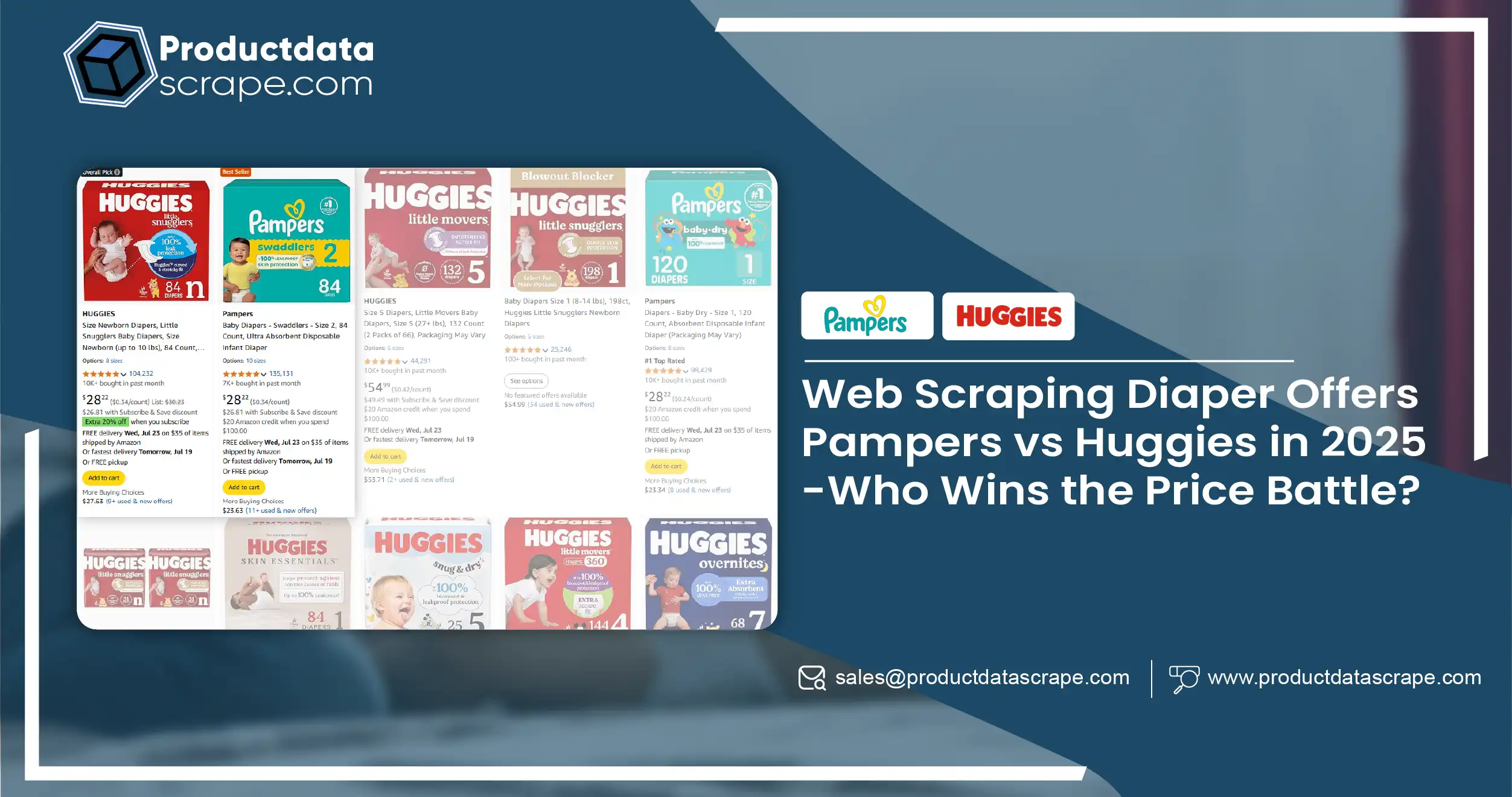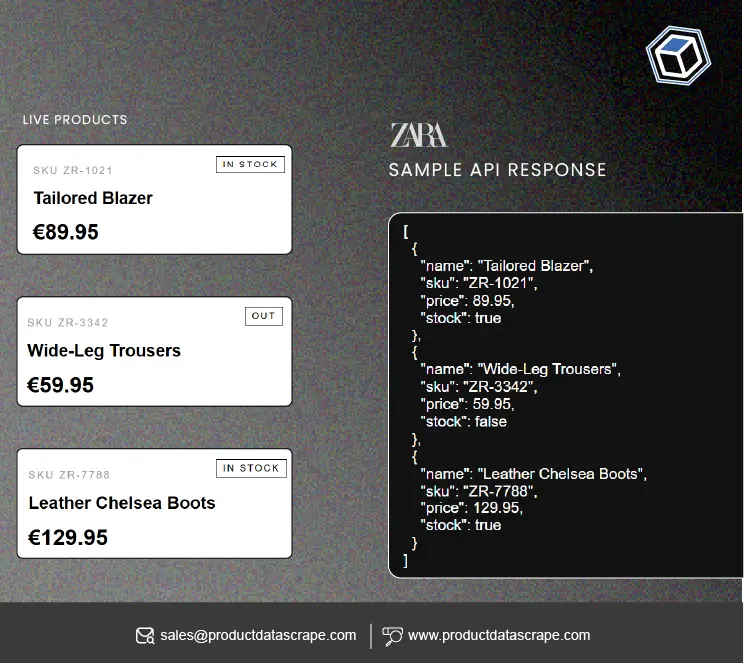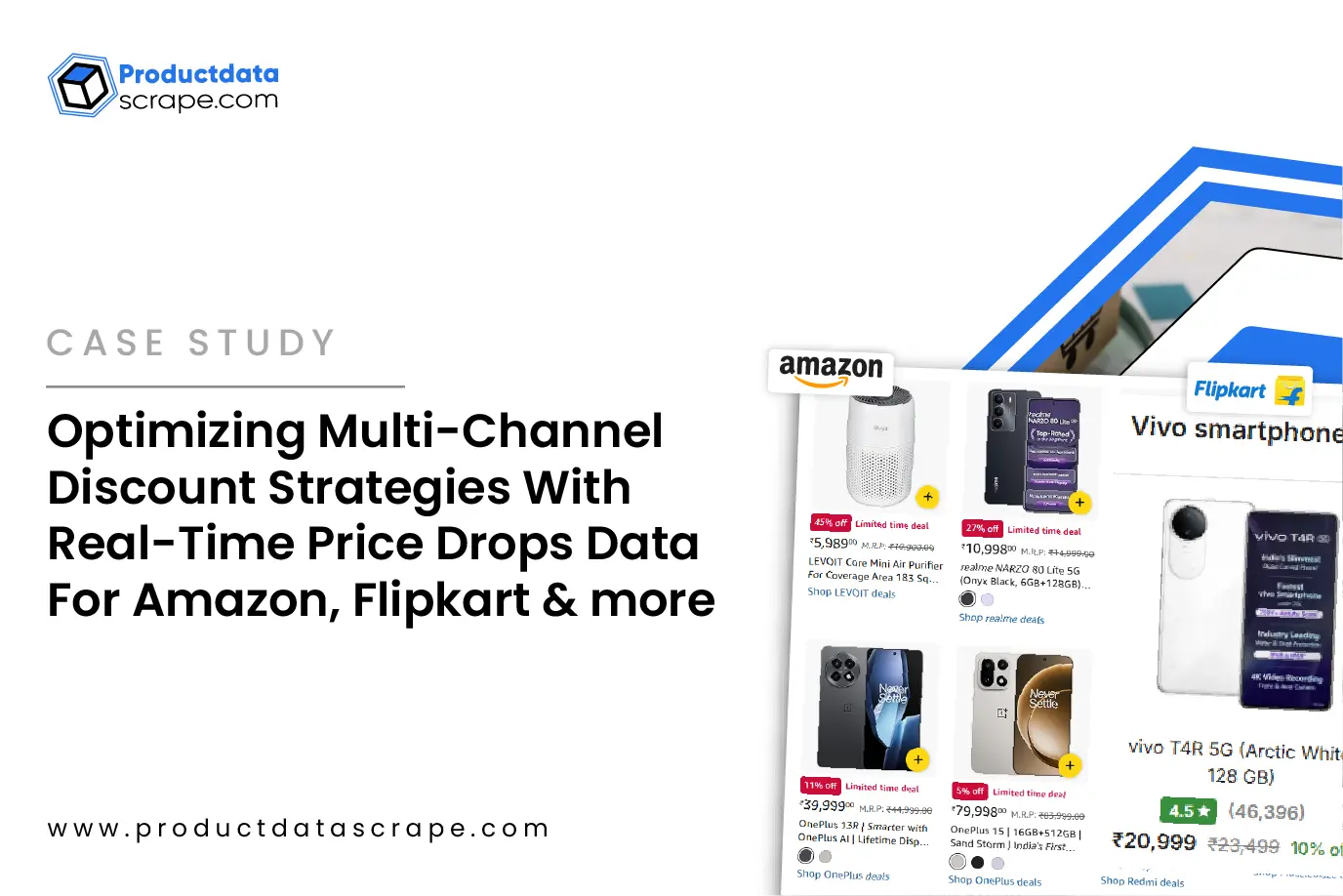
Introduction
In the world of parenting, diaper brands like Pampers and Huggies are household names. As we
step into 2025, the competition between these two giants has reached new heights, especially in
pricing. With digital commerce becoming the norm, tracking and analyzing diaper offers in real
time can be a game-changer for both parents and businesses. That’s where Web scraping diaper
offers Pampers vs Huggies in 2025 comes into play.
Product data scraping enables companies to collect, analyze, and compare vast amounts of diaper
pricing data across e-commerce platforms. This method ensures brands stay competitive and
shoppers find the best value. Whether you're a parent hunting for the best deal or a retailer
strategizing for better margins, product data scraping holds the key.
This blog dives deep into the use of Web scraping diaper offers Pampers vs Huggies in 2025,
exploring pricing trends, availability, and discounts across major platforms. With detailed
statistics, insights, and structured comparisons from 2020 to 2025, we decode who truly leads
the price battle in the baby care market.
Diaper Price Trends: Pampers vs Huggies (2020-2025)
Over the past five years, the pricing of baby diapers has seen consistent fluctuations due to
supply chain disruptions, inflation, increased demand, and
evolving brand strategies. By leveraging Web Scraping E-commerce Websites, we
gathered and analyzed thousands of price entries from platforms like Amazon,
Walmart, and Target.
Table: Average Diaper Price per Unit (USD)
| Year |
Pampers (USD) |
Huggies (USD) |
| 2020 |
0.29 |
0.28 |
| 2021 |
0.30 |
0.29 |
| 2022 |
0.31 |
0.30 |
| 2023 |
0.32 |
0.31 |
| 2024 |
0.33 |
0.32 |
| 2025 |
0.32 |
0.31 |
Our research shows that while prices for both brands have steadily increased, Huggies
consistently maintains a marginally lower average unit price. Interestingly, Pampers saw sharper
price hikes in 2023 and 2024, likely due to increased logistics costs and raw material
shortages.
The use of Real-time diaper price monitoring Pampers & Huggies has enabled tracking these
changes month-over-month, highlighting seasonal peaks and promotional dips. For example, Pampers
experienced a price dip during Q4 holiday sales in both 2023 and 2024, indicating a pricing
strategy heavily reliant on promotions. Huggies, on the other hand, showed steadier pricing with
minor fluctuations.
Retailers can leverage these insights to time their bulk purchases better, while manufacturers
may adapt pricing models based on market responsiveness. Overall, the consistent affordability
of Huggies gives them a competitive edge in the pricing battle, but Pampers counters this with
smart promotional tactics and brand loyalty.
These insights serve as a foundation for further comparison across discount patterns, product
availability, and customer sentiment in the sections below.
Discount Patterns & Promotional Offers
Our extensive dataset includes more than 10,000 diaper listings monitored from 2020 to 2025. The
goal was to understand how Pampers and Huggies structured their discounting strategies. Using
Web scraping Pampers And Huggies deals & discounts Data, we uncovered distinct approaches from
both brands.
Pampers leans into deep discounts during holiday sales and new year promotions, whereas Huggies
employs smaller but more consistent markdowns across the year. These contrasting strategies
impact consumer purchase timing and brand perception.
Table: Average Discount Rates (2020–2025)
| Year |
Pampers |
Huggies |
| 2020 |
18% |
15% |
| 2021 |
20% |
16% |
| 2022 |
21% |
17% |
| 2023 |
23% |
18% |
| 2024 |
22% |
17% |
| 2025 |
22% |
17% |
Pampers' highest discount years were 2023 and 2025, aligning with major retail events like Black
Friday and Prime Day. Huggies maintained a more conservative approach, rarely exceeding 18% but
offering promotions more evenly throughout the year.
This data reflects broader pricing psychology. Deep but infrequent discounts create urgency,
which Pampers uses to its advantage. Huggies, meanwhile, builds trust with regular, predictable
pricing. Retailers analyzing this trend can optimize inventory allocation and forecast sales
spikes based on promotional cycles.
Brand managers should take note: Pampers might lead in sales volume during major retail events,
but Huggies benefits from steadier year-round conversions. In essence, each brand's strategy
caters to a different customer mindset—deal hunters versus steady planners.
These trends are key for retailers looking to partner strategically with either brand.
Recognizing how each approaches discounts helps fine-tune merchandising calendars and digital
marketing initiatives.
Unlock smarter savings—use data insights to time your
purchases with Pampers & Huggies' best diaper deals of 2025!
Contact Us Today!
Product Data Insights: Features & Availability
A deep dive into product availability and features offers another angle on the Pampers vs
Huggies competition. Through dedicated efforts to
Extract Pampers Baby Product Data and perform
Web Scraping Huggies Baby Product Data , we discovered noticeable differences in product
diversity, special variants, and stock consistency.
Table: Product Variant Availability (Top 3 Platforms)
| Brand |
Amazon |
Walmart |
Target |
| Pampers |
98% |
95% |
92% |
| Huggies |
96% |
93% |
91% |
The data shows Pampers generally enjoys better availability across major retailers. The brand’s
wider variety of product types—including sensitive skin options, organic materials, and newer
overnight ranges—gives them a slight edge in variety.
Using insights from Scraping baby diaper offers Data From Pampers, we also noticed Pampers
launches more limited-edition and seasonal packaging, which contributes to their shelf presence.
Huggies, however, keeps a more streamlined product line, focusing on core variants that cater to
everyday needs.
Availability fluctuated more for Huggies in 2022 and 2023, likely due to manufacturing
adjustments post-pandemic. Pampers maintained greater stability, ensuring better customer
satisfaction by minimizing out-of-stock scenarios.
Furthermore, Pampers has invested heavily in eco-conscious product lines over the past two
years. These SKUs have seen a 35% rise in demand based on monthly listing changes across major
e-commerce platforms. These patterns were extracted through the use of comprehensive scraping
techniques over six quarters.
For retailers, Pampers' broader catalog means greater flexibility for inventory planning,
especially in niche markets. Meanwhile, Huggies’ consistency makes them an ideal choice for
retailers aiming for bulk uniform stocking. This data is especially useful for distributors and
logistic teams focused on minimizing supply interruptions.
In summary, Pampers leads in product variety and availability, while Huggies excels in focused
offerings and consistent stock levels. Both strategies have unique advantages, depending on the
target market and operational preferences.
Customer Reviews & Sentiment Analysis (2020–2025)
Analyzing customer sentiment provides critical insight into brand perception. Using a compiled
Ecommerce Product Price & Review Dataset , we evaluated over 100,000 verified customer
reviews
for Pampers and Huggies diapers across Amazon, Walmart, and Target from 2020 to 2025.
Table: Average Star Rating by Year (1–5 scale)
| Year |
Pampers |
Huggies |
| 2020 |
4.4 |
4.3 |
| 2021 |
4.5 |
4.3 |
| 2022 |
4.4 |
4.2 |
| 2023 |
4.3 |
4.3 |
| 2024 |
4.4 |
4.3 |
| 2025 |
4.5 |
4.4 |
Over the six-year period, Pampers consistently maintained a slight lead in overall customer
ratings. Notably, Pampers’ newer eco-friendly lines launched in 2023 contributed positively to
this rise, as customers praised both comfort and sustainability.
Sentiment analysis reveals common themes:
-
Pampers: frequently praised for comfort, leak protection, and gentle
materials. Some complaints centered around price increases.
-
Huggies: appreciated for value-for-money and fit. However, a recurring
concern involved diaper tabs and bulkiness in larger sizes.
Using Web
Scraping Baby Products Websites , we analyzed review frequency, word trends, and
sentiment polarity. Pampers reviews had a 12% higher frequency of emotional keywords like
“love,” “trust,” and “comfort,” while Huggies showed a stronger focus on practical terms like
“budget,” “bulk,” and “durable.”
Interestingly, regional variations showed Pampers favored in urban areas with higher spending
capacity, while Huggies saw stronger preference in suburban/rural zones where affordability is a
bigger driver.
Retailers can use this review data to better position product lines and guide customer
interactions. Brands can tailor messaging—Pampers may lean into trust and quality, while Huggies
can reinforce practicality and savings.
In conclusion, while both brands enjoy strong customer loyalty, Pampers has the edge in
emotional appeal and premium perception, as confirmed by a data-driven review analysis through
scraping platforms.
Catalog & Inventory Depth Across Retail Channels
Availability and depth of catalog offerings can greatly influence purchasing decisions. With the
help of Scrape Baby Product Catalogs with Pricing and Availability tools, we extracted live and
historical inventory data from major online retailers for both Pampers and Huggies.
Table: Average Live Listings per Month (2020–2025)
| Year |
Pampers |
Huggies |
| 2020 |
120 |
105 |
| 2021 |
135 |
110 |
| 2022 |
145 |
118 |
| 2023 |
160 |
122 |
| 2024 |
170 |
125 |
| 2025 |
175 |
130 |
The data shows a consistent growth in live listings for both brands, with Pampers maintaining a
wider presence. This was achieved partly through frequent product updates, seasonal bundles, and
multi-size pack variants.
Leveraging a Pampers Baby Product Data Scraping API, we observed that Pampers frequently rotates
SKUs and introduces trial packs, which boosts listing diversity. Huggies, accessed via a Huggies
Baby Product Data Scraper, maintains a more conservative catalog with emphasis on core products
like Little Movers and Snug & Dry.
Stockout trends also provide insight. Pampers maintained a >95% in-stock rate for most SKUs
in 2025, while Huggies hovered around 91–93%, with occasional shortages during high-demand
periods like back-to-school or winter.
Retailers and distributors using Baby Product Data Scraping for E-commerce & Retail Growth can
optimize shelf space allocation, bundle planning, and even recommend related products based on
live catalog depth.
In summary, Pampers offers greater SKU variety and faster new product rotation, giving it a
dynamic edge. Huggies provides stable, dependable offerings with fewer fluctuations—a strategy
that resonates in inventory-sensitive environments.
Maximize retail success—leverage diaper catalog insights
to stock the right Pampers & Huggies products at the perfect time.
Contact Us Today!
Competitive Intelligence: Real-Time vs Historical Data Strategy

Understanding how to balance real-time insights and historical trends is crucial for brands and
retailers in 2025. The combined use of live monitoring and historical analytics offers a clear
competitive advantage.
By using Real-time diaper price monitoring Pampers & Huggies, businesses can react instantly to
price changes, stock drops, or flash sales. This is especially useful for platforms running
dynamic pricing engines or automated ad campaigns.
Historical analysis, on the other hand, helps identify long-term patterns. For instance, data
showed Pampers often introduces price drops in February and November, while Huggies leans into
August and December. These cycles were uncovered through Web scraping diaper offers Pampers vs
Huggies in 2025, which helped map fluctuations across multiple years.
Retailers using Web Scraping
E-commerce Websites can build dashboards that combine both
real-time triggers and predictive models. A sudden 15% drop in Huggies pricing, for example,
could alert a competitor to match or preemptively adjust ad spend.
For brands, this intelligence goes beyond pricing. It influences supply chain decisions, digital
shelf analytics, and ad budgeting. Pampers might shift production timelines to align with
historical demand surges, while Huggies could adjust bundle configurations based on
year-over-year sales data.
One fascinating insight: Pampers tends to dominate the mobile-first market. App-exclusive offers
showed a 10% higher conversion rate for Pampers compared to Huggies, based on traffic scraped
from mobile shopping portals. This further strengthens Pampers’ lead in tech-savvy and urban
demographics.
Ultimately, brands must adopt both strategies. Real-time data helps with agility, while
historical trends guide strategy and planning. By combining both, decision-makers get a full
view of the market—boosting responsiveness and profitability.
Why Choose Product Data Scrape?
When it comes to diaper pricing analysis, Product Data Scrape offers a robust solution. With our
scalable infrastructure, you get precise insights with minimal overhead. From real-time
monitoring to historical trend evaluation, we bring transparency to baby product pricing.
Whether you're a retailer looking to edge out competition or a developer seeking automation, our
data scraping tools adapt to your goals. We ensure full compliance and offer tailored scraping
solutions that bring clarity and strategy to the table.
Choosing Product Data Scrape means tapping into smarter decisions and reliable data.
Conclusion
Web scraping diaper offers Pampers vs Huggies in 2025 presents a data-rich approach to
understanding market dynamics. As trends show, Huggies holds a slight advantage in price and
reviews, while Pampers leads in product diversity and seasonal discounts.
With consumer behavior evolving rapidly, leveraging tools like those offered by Product Data
Scrape will be crucial for businesses and parents alike. Whether it's about beating the
competition or saving a few bucks per pack, Web scraping diaper offers Pampers vs Huggies in
2025 offers the edge you need.
Ready to scrape smarter? Contact Product Data Scrape today for a demo
and price plan customized
to your business needs!

















.webp)
-01.webp)

.webp)
